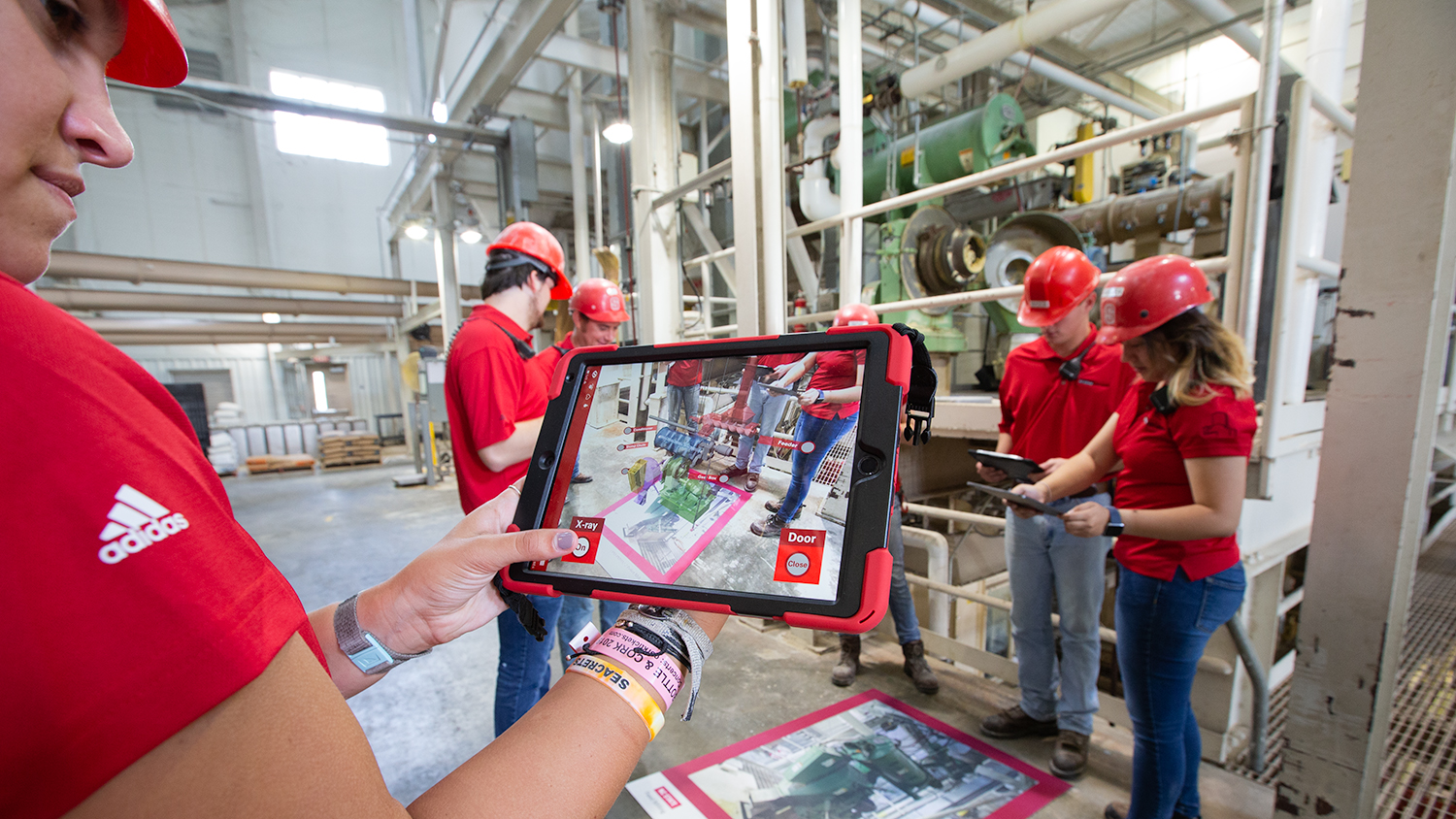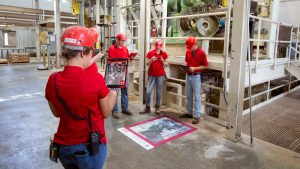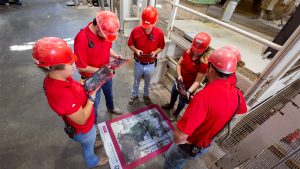An Inside Look at Feed Milling: Bringing Augmented Reality to Distance Education

NC State’s Feed Mill Education Unit has become a magnet for emerging technologies and innovation thanks to several DELTA staff members and two faculty members from the Prestage Department of Poultry Science.
In 2018, Area Specialized Agent, Animal Food Safety Marissa Herchler and Assistant Professor, Feed Milling Adam Fahrenholz completed a Blended Learning grant to streamline their “Build Your Own Feed Mill” assignment and improve tours of the facility by capturing it in virtual reality. Now, they’re striving to further enhance the learning experience and immerse their students in perspectives not yet explored.
Fahrenholz is the lead instructor for the various feed milling courses and coordinates the academic and extension missions of the feed milling program. Herchler, who is also pursuing a minor in Agricultural and Extension Education along with her Ph.D. in Poultry Science, has engaged in projects with DELTA in order to leverage educational opportunities that will benefit students and industry personnel from an animal food safety perspective.
Most recently, through the awarding of a DELTA Exploratory grant, they have worked from Aug. 2018 to Aug. 2019 to recreate the feed mill’s machinery and processes in augmented reality (AR) for FM 480: Feed Quality and Assurance Formulation.
The course serves both traditional and distance education (DE) students, including industry personnel pursuing the Undergraduate Feed Milling Certificate, presenting unique instructional challenges. DELTA project team members Donnie Wrights, Cathi Dunnagan, Ben Huckaby and Janna Martin found that it was a ripe opportunity to implement AR to the benefit of all students.
Stepping Inside a Feed Mill
NC State’s Feed Mill is a dynamic operation. There are countless moving parts and processes, each crucial to maintaining balance, order, efficiency, and the nutritional adequacy and safety of the animal food. But most of these processes take place inside of machines, hidden from a spectator’s view. While necessary to maintain a safe environment and keep production moving along, this physical barrier can become a learning barrier for students.
“We really liked how well the virtual tour turned out from our first DELTA grant, but it became important that we be able to tell the whole story of the feed mill,” says Herchler. “We needed a way to demonstrate to students and industry how the equipment works without disrupting the processes. This was the perfect application for AR.”

The faculty and the project team from DELTA set out to create a versatile AR experience that could be applied not only in the feed mill, but in many environments and for different purposes the program serves, like NC State Extension courses.
Lead Interaction Designer/Developer Ben Huckaby began by designing 3D models of feed mill equipment that move and conduct real processes, which he exported into Zappar, an AR platform and creative studio. By downloading the mobile app, students can unlock AR experiences on their phones that correspond with a lesson or tour in real time. All they need is a Zapcode, an image target and a level surface (view at the end of the article). This approach represents just one of the options that educators have when exploring AR.
“It is something timely. They can be in the feed mill itself,” says Huckaby.
“You can take people to places where they cannot physically go, and that’s really cool,” adds Cathi Dunnagan, lead instructional designer.
To prepare, the team asked a lot of questions about AR’s limitations, capabilities and materials. Most importantly, they needed to know how to present the course material thoroughly and simply, without letting the technology itself distract or obstruct. To achieve this, they added informational pop-up buttons attached to the AR machines as a supplemental learning tool.
The team faced challenges as they encountered the quirks of a new technology and an unfamiliar user interface during production, but despite the “rollercoaster,” they’re proud to present an immersive experience that all students can engage with.
“It is so easy to use. If you download it and there’s a code, you can see it. It is very intuitive,” says Dunnagan. “The fact that AR technology is now coming down in cost so that we can have it in education is fantastic.”
Learning Impacts and Leveling the Field
“One of the strengths of AR is being able to focus on one particular subject, in this case machinery, and bring it into your reality,” says Huckaby.
Augmented reality in education is a new terrain that is experiencing rapid exploration –– and for good reason. The technology’s potential impacts to student success are far-reaching and transformative, especially in mechanical fields like agriculture and food production.
“When an instructor is explaining how equipment works, the students have to build this image in their minds. By using AR, we are able to show students exactly what we want them to see and how it impacts the processes,” says Herchler.
For a class like FM 480 with both in-person and distance education students, it can be difficult to give each student the same experience. Students taking the class in person can visit and see the mill in action, whereas remote students cannot. AR works to close this gap.
“The AR experience puts everybody on the same playing field. Anybody that goes in and does the AR experience will get the same information,” says Donnie Wrights, senior educational media developer.
Traditional students first encounter AR at the feed mill. The instructors wanted to show them the inside of the machines in person, so they created large floor mats as image targets. By scanning these mats, students can spawn machine interiors on top of the actual machine and watch the inner processes as they take place. They can even walk around and step inside them. After the tour or while they review for an exam, they can download image targets and re-launch the experience in their own space.

In the feed mill, instructors and students create a shared experience.
“They can see each other, talk to each other; they can share the experience. AR lets those conversations happen [with] an excitement and buzz about seeing something you can’t see with your eyes,” explains Dunnagan.
No matter their location, a DE student can print an image target — or in the case of a 500-pound mixer, simply find a flat surface — and launch the same experience at any time and at the same high quality as traditional students. It also enhances a class’s sense of community, as all students share the same perspective of course material. DE students can see the machines and processes exactly as they take place in the mill directly in front of them, placing a mixer in their living room or a pellet mill on their desk.
“You can take people to places where they cannot physically go,” adds Dunnagan. “Having that opportunity to engage with content, rather than reading it flat on a page or watching a flat video, but actually being able to interact with it, I think that’s where the additional learning happens.”
Future Applications
Right now, Herchler and Fahrenholz are looking forward to bringing the AR mats to conferences and sharing this project with industry leaders, the same people they’re expecting their students and extension constituents to work with.
“Many students will eventually go on to work in a feed mill,” Herchler says. “We are trying to be ahead of the curve on new applications so students will be prepared and can adapt when they are implemented on the industry level.”
The project team believes AR has the potential to become an impactful learning technology for a wide scope of subjects, ages and professional disciplines.
Chemistry and gross anatomy labs, horticultural tours and location-based learning activities are just a few of the areas mentioned where AR can improve the way students immerse in a subject and interact with course material. As the technology becomes more affordable, it also presents promising applications to K-12 education. And it’s already expanding close to home; faculty from Marine, Earth, and Atmospheric Sciences are exploring a location-based tour of NC State’s rock composition on campus using the technology.
In the near future, Herchler sees AR inspiring students inside the classroom and beyond.
“I think adding AR will encourage students to think outside the box even after they leave the course. This is a novel technology not being utilized in much of their coursework.”
Wrights credits Herchler’s and Fahrenholz’s enthusiasm for innovation as a driving force behind the project. In making the connection between feed milling and immersive technology and enlisting DELTA’s resources, they’ve sparked an age of advancement for students and educators in feed mill studies at NC State and beyond. Herchler fully expects to be able to utilize these tools in the field, providing a new set of resources related to her work in educating producers on important aspects of animal food safety.
As we dive deeper into immersive reality at DELTA, we look forward to finding new ways for students to learn and succeed.
“It’s always changing. We push it, and it pushes us,” says Dunnagan.




